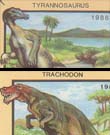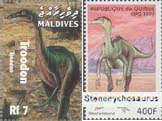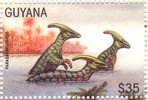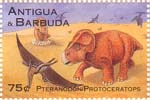The errors can be categorized as follows:
- Spelling errors
- Wrong / transposed names
- Synonyms
- Wrong titles / information
- Wrong reconstructions
- Outdated reconstructions
- Impossible juxtapositions
- Temporal
- Geographical
- Ecological
|
Errors on stamps have always fascinated me. In this section I do not list all individual errors, but
discuss them briefly in general terms. All errors that I am aware of are mentioned in the separate
'details' pages for each issue. The errors can be categorized as follows:
|
|
|
|
|
|
Spelling errors are quite common on prehistoric animal stamps, and show (to my mind) clearly that many issues are solely intended for quick sale to collectors. Admittedly the names of many species are complex tongue-twisters, the name of the pterosaur Rhamphorhynchus (with no fewer than 4 'h'-s!) is particularly prone to being misspelled. Still, most of these errors could and should have been avoided. They can be funny, though. Early 2002, just after the introduction of our new Euro currency, I bought a set of Central African Republic stamps, in which the name 'Euoplocephalus' was misspelled . . . as 'Europlocephalus'. |
|
| Triceratops mis-spelled. From a 1993 Romanian stamp. |
|
|
This is a category of errors that should also be very small, as a minimum of care during stamp design will ensure that they are eliminated. However, a number of them do exist. Comparison with the source illustration shows that, in a number of cases, the names of two species in one illustration were transposed during stamp design. This certainly happened in the case shown at right: the two species are shown together on a Burian painting. 'Trachodon' is an invalid name, based on a poorly preserved tooth that could have belonged to just about any hadrosaur. Invalid names are a kind of error which is fairly rare. Therefore, I decided do not treat this error separately. |
 |
| Transposition of the names Tyrannosaurus and 'Trachodon' on 1988 Laos stamps. |
|
|
Synonyms are a special category of wrong names. Every species has, of course, just one scientific name. This seems very straightforward, but for one problem: when leg bones of an unknown animal are found, who is to know whether they belong to the same species as a skull found earlier? The best known example is the dinosaur Apatosaurus. This animal had been known to the world as Brontosaurus for some 75 years before the fact that remains of the same species had already been named Apatosaurus became widely known. Thus, the name Brontosaurus is correct on older stamps, but wrong on more recent ones. |
 |
| Stenonychosaurus is synonymous with Troodon, the latter being the correct name. (Names magnified) |
|
|
Stamps and sheet / M.S. margins often have additional information or titles printed on them. Often, these are little informative ('Prehistoric Animals'), and all too often misleading. Of course, one can hardly go wrong with a title like 'Prehistoric Animals', but try counting non-dinosaurs in sheets presented under 'Dinosaurs'. . . Other sets are titled 'Aquatic (or Marine) Dinosaurs' or 'Flying Dinosaurs', even though all dinosaurs were strictly terrestrial. A set from Guyana titled 'Jurassic Dinosaurs' includes both Triassic and Cretaceous species. |
 |
| The 150-th anniversary of the word 'Dinosaur'.
But Dimetrodon IS not a dinosaur. . . |
|
|
In this category are errors such as the Rhamphorhynchus without a tail, shown on a Tanzanian miniature sheet, or Tyrannosaurus with more than two fingers. This type of error is rare when illustrations are copied from literature, they are far more typical for quick, sloppy illustrations by (second rate) stamp designers. |
 |
| Tyrannosaurus reconstructed with a four-fingered hand. From a 1988 Central African Republic stamp. |
|
|
In this category, dinosaurs feature prominently. Due to their impressive size and looks, these animals have always caught the imagination of many. As a consequence, there have been many popular books on them, and not all of these have been very well researched and up to date with scientific ideas. Also, the past decades have seen a major shift in scientific thought. Dinosaurs are no longer thought of as slow and dumb, but as agile, well-adapted, successful animals. It is now well accepted that bipedal dinosaurs held their backs and tails horizontally, and were good walkers, even runners. Sauropods also held their tails up, and lived on land, not in swamps and lakes, as thought earlier. Some of these new ideas rapidly found their way to stamps. Nesting behaviour and parental care (Maiasaura) have been depicted a number of times. On the other hand, many new stamps still show dinosaurs dragging their tails and/or with their backs at 45 degree angles. |
 |
| Parasaurolophus reconstructed as amphibious. The idea of hadrosaurids as semi-aquatic has (mostly) been abandoned for decades. |
|
|
|
There are three reasons for which a combination of prehistoric species may be impossible: 1) TEMPORAL When the species are of different ages; this kind of error is called an anachronism. 2) GEOGRAPHICAL When the species lived in different areas. Maybe this is a surprise, but the combination of Tyrannosaurus and Pteranodon (see above) is also unlikely for this reason. Fossils of the latter are found in Kansas, while Tyrannosaur fossils are found in Montana, Wyoming and Alberta (Canada). 3) ECOLOGICAL When the lifestyle of the species are so different that they would never have occurred together, or would
not have interacted as they are shown. | ||||
 |
Pteranodon lived in North America in the middle part of the Late Cretaceous, Protoceratops is a central Asian species living during the middle part of the Cretaceous. |  |
Struthiomimus shown with a dragonfly in its mouth, an unlikely catch. | |
|
|
|